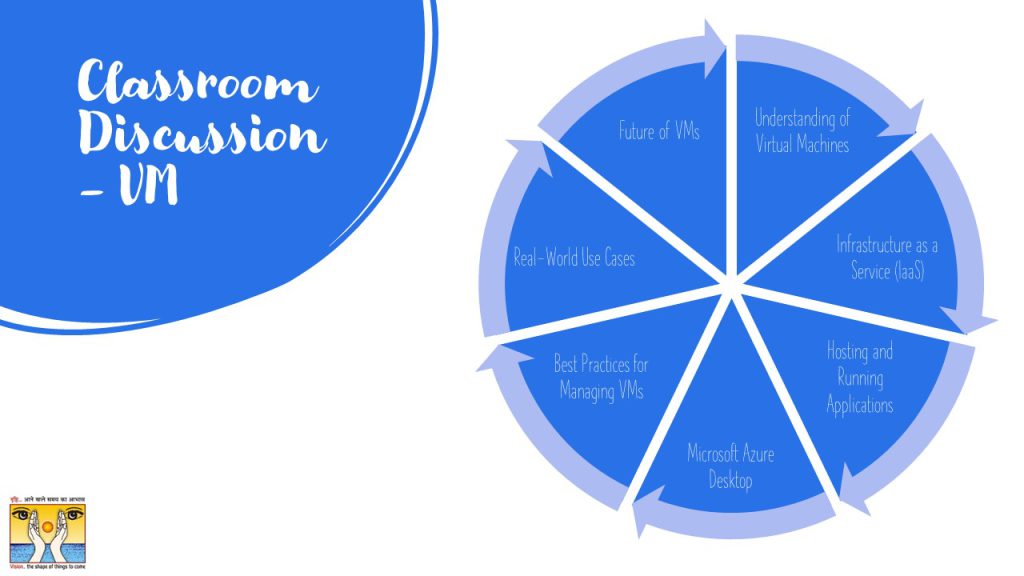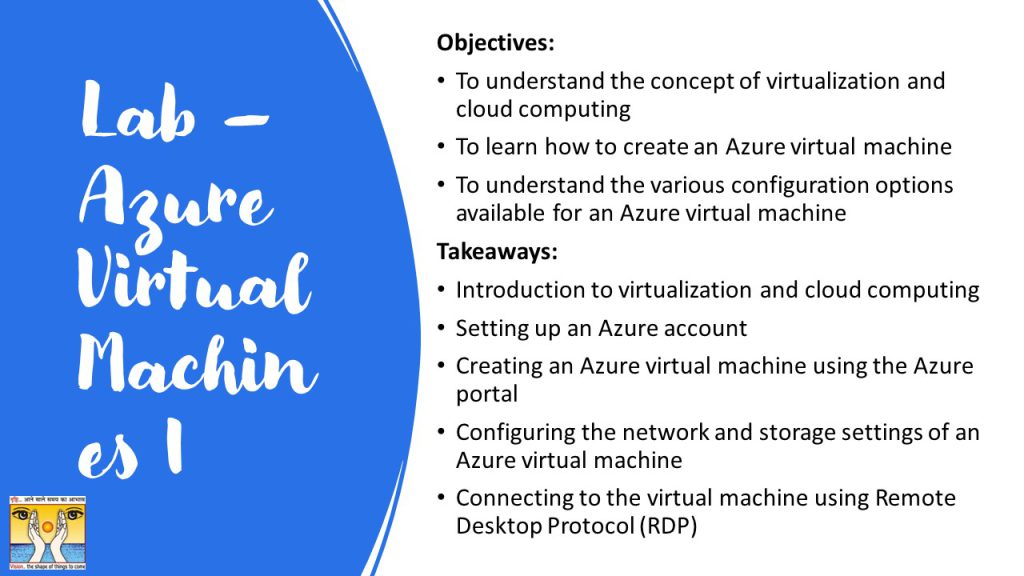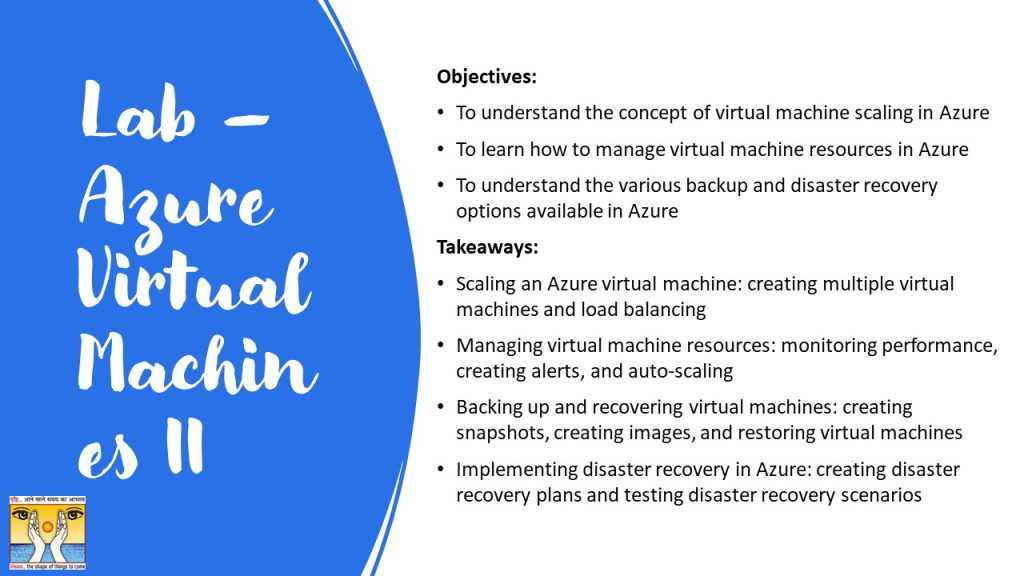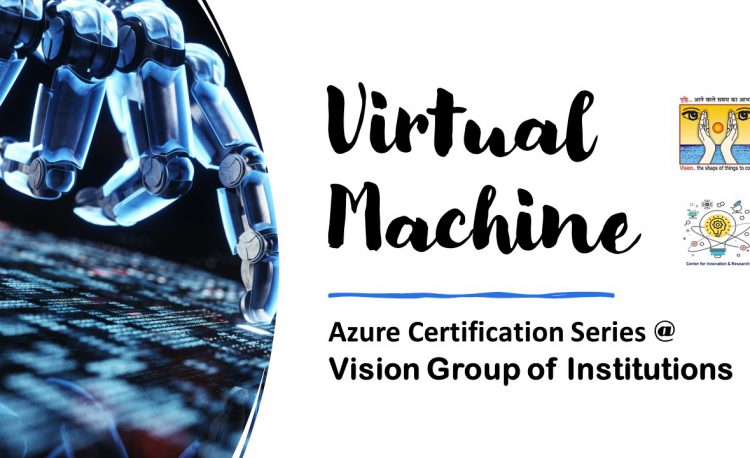Virtual Machines (VMs) are software-based emulations of physical computer systems that run on top of a physical host machine. They provide a virtualized environment for running operating systems and applications, and offer benefits such as increased flexibility, scalability, reliability, security, and cost-effectiveness. VMs are a popular solution for hosting and running applications at remote locations, as they can be accessed from anywhere with an internet connection. At Azure Certification Course of VIT we give you hands on training on various aspects of building & hosting VM on Azure
VM in Azure Certification Series (ACS)@ VIT
Virtual Machines (VMs) play an important role in the Azure Certification Series @ VIT as they provide hands-on training on a crucial aspect of cloud computing. This training covers various aspects of VMs, including hosting and running applications, infrastructure as a service (IaaS), security, and management best practices. This hands-on experience will be extremely useful for students in their projects, professional work, and research, as they will be able to apply their knowledge of VMs in real-world scenarios. The inclusion of VMs in the Azure Certification Series @ VIT is an excellent opportunity for students to gain practical skills and deepen their understanding of cloud computing technologies.
Program Coaches
- Amarendra Chaudhary
- Anurag Pandey
VM- Virtual Computers in Cloud
Virtual Machines (VMs) are software-based emulations of physical computer systems that run on top of a physical host machine. They behave as if they were separate computers, with their own operating systems, resources, and applications. VMs can be created, deleted, and scaled as needed, making it easy to allocate resources on-demand and respond to changing workloads. They are also useful for server consolidation, testing and development, disaster recovery, security and increased flexibility, scalability, and security, making them a valuable tool for modern computing environments.
VMs are a type of Infrastructure as a Service (IaaS), which is a cloud computing service model that provides virtualized computing resources over the internet, including virtual machines, storage, and networking. IaaS allows customers to rent virtualized computing resources on a pay-as-you-go basis, avoiding the upfront capital costs of purchasing and maintaining physical infrastructure. Customers can create and manage their own virtual machines, configure their network and storage, and run their own applications, giving them a high degree of control and flexibility.
Advantages and Industry uses
VMs are also a good option for hosting and running applications at remote locations, as they can be accessed from anywhere with an internet connection. They provide high accessibility, scalability, reliability, security, and cost-effectiveness. Hosting applications on VMs can be more cost-effective than purchasing and maintaining physical servers, especially for small and medium-sized businesses.
Microsoft Azure offers a service called Azure Desktop that provides Windows virtual desktops in the cloud, hosted on Azure virtual machines. Azure Desktop allows users to access their desktop and applications from anywhere, on any device, with a high-speed, low-latency connection. The virtual desktops are fully managed and maintained by Microsoft, so users don’t need to worry about updating or patching the underlying operating system.
Added Services like Azure Desktop
Virtual Machines (VMs) are a powerful tool for modern computing environments that provide many benefits including increased flexibility, scalability, and security. They are a type of Infrastructure as a Service (IaaS) that provides virtualized computing resources for customers to rent and use over the internet, and are a good option for hosting and running applications at remote locations. Microsoft Azure provides a service called Azure Desktop that provides Windows virtual desktops in the cloud, making it easy for users to access their desktop and applications from anywhere.
Learning Outcomes of Class-Room Discussions
Virtual Machines (VMs) are software-based emulations of physical computer systems that run on top of a physical host machine. They behave as if they were separate computers, with their own operating systems, resources, and applications. VMs can be created, deleted, and scaled as needed, making it easy to allocate resources on-demand and respond to changing workloads. They are also useful for server consolidation, testing and development, disaster recovery, security and increased flexibility, scalability, and security, making them a valuable tool for modern computing environments.
VMs are a type of Infrastructure as a Service (IaaS), which is a cloud computing service model that provides virtualized computing resources over the internet, including virtual machines, storage, and networking. IaaS allows customers to rent virtualized computing resources on a pay-as-you-go basis, avoiding the upfront capital costs of purchasing and maintaining physical infrastructure. Customers can create and manage their own virtual machines, configure their network and storage, and run their own applications, giving them a high degree of control and flexibility.

VMs are also a good option for hosting and running applications at remote locations, as they can be accessed from anywhere with an internet connection. They provide high accessibility, scalability, reliability, security, and cost-effectiveness. Hosting applications on VMs can be more cost-effective than purchasing and maintaining physical servers, especially for small and medium-sized businesses.
Microsoft Azure offers a service called Azure Desktop that provides Windows virtual desktops in the cloud, hosted on Azure virtual machines. Azure Desktop allows users to access their desktop and applications from anywhere, on any device, with a high-speed, low-latency connection. The virtual desktops are fully managed and maintained by Microsoft, so users don’t need to worry about updating or patching the underlying operating system.
Virtual Machines (VMs) are a powerful tool for modern computing environments that provide many benefits including increased flexibility, scalability, and security. They are a type of Infrastructure as a Service (IaaS) that provides virtualized computing resources for customers to rent and use over the internet, and are a good option for hosting and running applications at remote locations. Microsoft Azure provides a service called Azure Desktop that provides Windows virtual desktops in the cloud, making it easy for users to access their desktop and applications from anywhere.
Azure Virtual Machines Lab I
Objectives:
- To understand the concept of virtualization and cloud computing
- To learn how to create an Azure virtual machine
- To understand the various configuration options available for an Azure virtual machine
Learning Outcomes:
- Introduction to virtualization and cloud computing
- Setting up an Azure account
- Creating an Azure virtual machine using the Azure portal
- Configuring the network and storage settings of an Azure virtual machine
- Connecting to the virtual machine using Remote Desktop Protocol (RDP)

Azure Virtual Machines Lab II
Objectives:
- To understand the concept of virtual machine scaling in Azure
- To learn how to manage virtual machine resources in Azure
- To understand the various backup and disaster recovery options available in Azure
Learning Outcomes:
- Scaling an Azure virtual machine: creating multiple virtual machines and load balancing
- Managing virtual machine resources: monitoring performance, creating alerts, and auto-scaling
- Backing up and recovering virtual machines: creating snapshots, creating images, and restoring virtual machines
- Implementing disaster recovery in Azure: creating disaster recovery plans and testing disaster recovery scenarios


